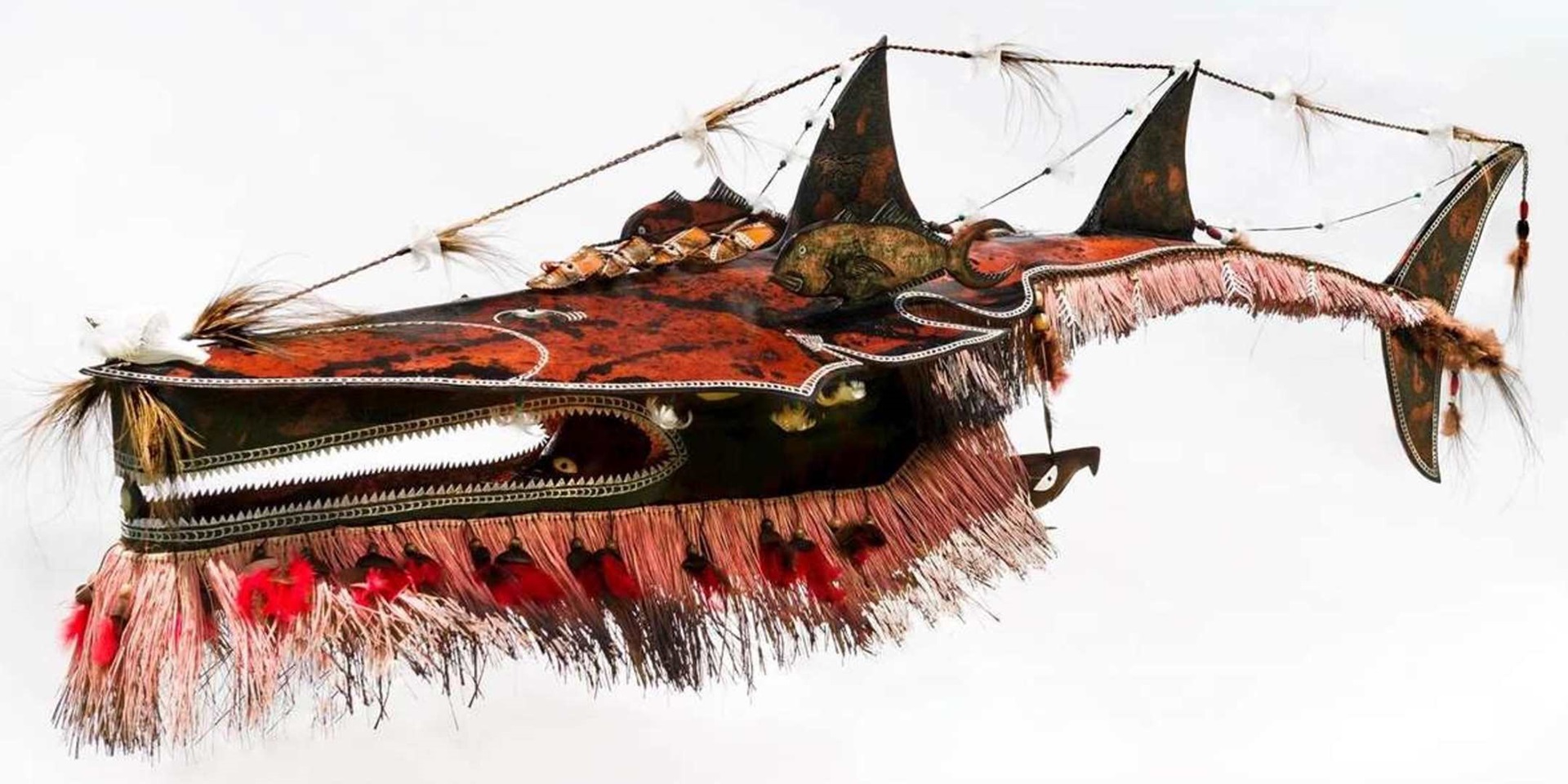

‘Zugubal’ 2006. Travellers paddle a gul (canoe), which is a key symbol of connectivity in Zenadh Kes (Torres Strait) cosmology, navigating all the cycles of land, sea, sky and spiritual life. ANMM Collection 00054665. Reproduced courtesy Alick Tipoti and Australian Art Network.
For thousands upon thousands of years, Aboriginal and Torres Strait Islander peoples have navigated their way across the lands and seas of Australia using paths called songlines or dreaming tracks. A songline is based around the creator beings and their formation of the lands and waters during the Dreaming (creation of earth). It explains the landmarks, rock formations, watering holes, rivers, trees, sky and seas.
Clan groups can, for example, demonstrate their infinite knowledge of place in the songs and dances passed down from generation to generation, in turn creating dreaming tracks for their area.
Songlines will often follow on from one another, creating an intricate oral map of place. Earth and water songlines are mirrored by sky songlines, allowing people to travel vast distances and highlighting the deep connection they have to earth and sea. Songlines are central to the existence of Aboriginal and Torres Strait Islander people and are imperative to the preservation of the world’s oldest living culture and its practices.
Contemporary Zenadh Kes (Torres Strait) artists such as Alick Tipoti and the late Billy Missi have used their art practice of lino print and 3D sculpture to express traditional navigation songlines and techniques to a wider audience. Some of their beautiful works can be found at the beginning of the museum’s new exhibition Ships, Clocks & Stars: the Quest for Longitude and in our NAIDOC week exhibition Munuk Zugubal – Saltwater Songlines.

‘Kulba Yadail (Old Lyrics)’. The work tells the story of how Torres Strait Islanders learn to read the stars, the moon and the sea to understand the four seasons of Zenadh Kes (Torres Strait). ANMM Collection 00049227. Photograph: Andrew Frolows/ANMM. Estate of the late Billy Missi/Licensed by Viscopy, 2016.
Missi’s linocut work Kulba Yadail (Old Lyrics) relates how Torres Strait Islanders learn to read the stars, moon and the sea to understand the four seasons of the Zenadh Kes and shows the significance of star constellations and seasons in orientating everyday life in Zenadh Kes. The work is divided into three parts: the constellation of the stars, the land and the four seasons of the Zenadh Kes, all of which link together. There are important Zugubal (star constellations) that move through the sky and are intimately connected to the four seasons. One of the most important Zugubal is the Baydham (Shark), which is closely observed in the Western Torres Strait as a signal for changes in the tides, winds and seasons. The four seasons are represented as Sager (south-east trade winds) Gabu Thornar (winter), Naigai (the calm northerly wind before monsoon) and Kuki (the monsoon).
Missi explains, ‘Kulba Yadail teaches us to read the stars, the moon and the sea. Kulba Yadail describes our environment, our culture and also our identity. In our culture, the stories and other knowledge of our world have always been handed down orally from generation to generation since time immemorial. It is this knowledge that provides guidance. From the boys’ perspective, it is their uncles, fathers and sometimes grandfathers who teach them this knowledge. The relationship between the stars and the seasons determines when we can cultivate, hunt and harvest the food from the sea and land.’

‘Kaygasiw Usul’. The sculpture references star constellations and their relation to the movements of the shovel-nosed shark. ANMM Collection 00054384. Reproduced courtesy Alick Tipoti and Australian Art Network.
Alick Tipoti’s sculpture Kaygasiw Usul also references star constellations and the shark. Kaygasiw Usul means ‘the trail of dust underwater created by the shovel- nosed shark’ and is the language of the Maluyligal people of Zenadh Kes. The shark’s movement is reflected in the star constellation known as the Milky Way. The tide always changes when the Kaygasiw Usul star constellation swings as though it’s dancing with the Kisay (moon).
The artist explains:
This particular mask was inspired by the original turtle-shell masks in the British Museum in London UK. As a Torres Strait cultural protocol, I have not replicated it exactly as the original. Like my forefathers before me, I have composed and choreographed a traditional mask dance, only performed by men, about the star constellation that brings this mask to life. The two main totems depicted in this artwork are the Kaygas (shovel nose shark) and the Baydham (shark). The Kaygas Mask alone is associated with the ancient ancestral spirits known to us Torres Strait Islander people as the Zugubal. Gaygays (giant trevally) swimming along with the Kaygas shows that this Kaygas is from the deep sea and is called Koey Malu Kaygas.
The Kaygas is on top of a shark mask that is also connected to the Zugubaw Baydham (shark star constellation). The masks aligned on top along the centre of the Kaygas represent spiritual Mawa dancers performing a sacred ritual only for the eyes of the elders. Such rituals are only performed when a spirit is travelling to the other side. Inside the shark mouth is also a Mawa mask. This mask represents the sorcerer or the main dancer of the Kaygas clan picked by the spirits to perform this dance.
Songs, dances, oral histories and intricate masks are all examples of vessels that hold the songlines specific to each community area. Today, contemporary artists such as the late Billy Missi and Alick Tipoti demonstrate their Indigenous knowledge through their art as a modern record of their ancestral and spiritual connection to their identity as Zenadh Kes (Torres Strait Islanders).

